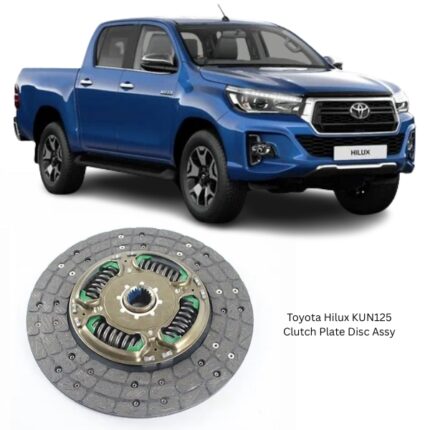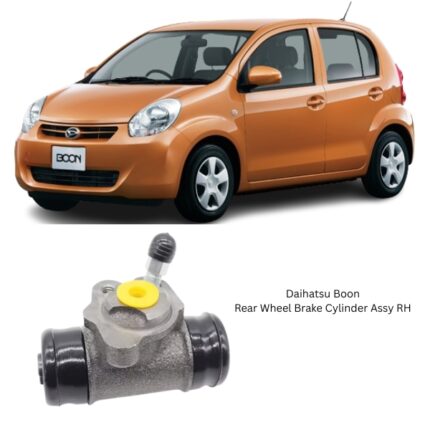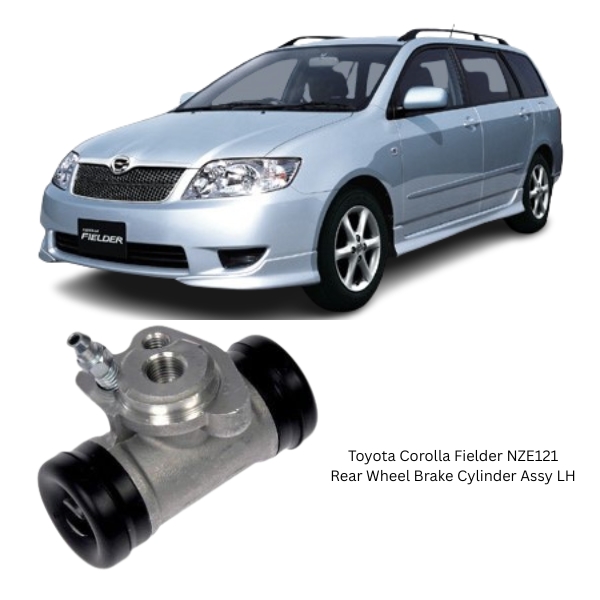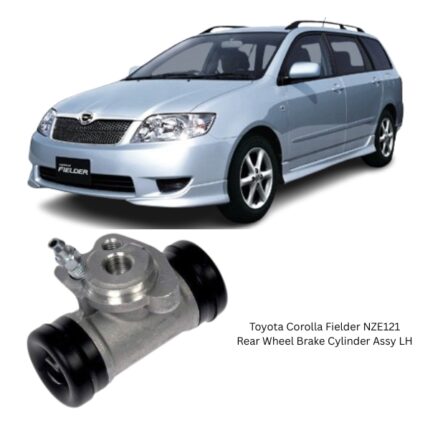Get Toyota Corolla Fielder NZE121 Rear Wheel Brake Cylinder Assy LH 47570-52011 in Kenya
The Rear Wheel Brake Cylinder Assembly LH (Left-Hand) is an essential hydraulic component within a drum brake system, playing a direct role in ensuring effective, balanced, and safe braking performance. Located inside the rear brake drum, this assembly converts hydraulic pressure from the brake fluid into mechanical force that presses the brake shoes against the drum, producing the friction necessary to slow down or stop a vehicle.
Operating quietly and efficiently behind the scenes, this part is critical to maintaining a smooth, responsive braking system. The rear wheel brake cylinder assembly’s reliability and precision are vital for preserving brake stability, ensuring consistent stopping power under various driving conditions.
Core Functionality
The primary job of the rear wheel brake cylinder is to convert hydraulic brake fluid pressure into a mechanical pushing force. When the brake pedal is pressed, brake fluid travels through the brake lines and enters the wheel cylinder. Inside the cylinder, fluid pressure pushes two pistons outward, each in an opposite direction. These pistons press the brake shoes outward until they contact the rotating drum, generating the necessary friction to reduce wheel speed.
Upon releasing the brake pedal, return springs pull the brake shoes back to their resting position, and the fluid pressure inside the cylinder drops, allowing the pistons to retract. The wheel cylinder must perform this operation repeatedly and consistently without failure.
Key Components
-
Cylinder Body
Usually made from cast iron or high-strength aluminum alloy, this component houses the internal mechanisms. It must withstand high pressure while resisting corrosion and deformation over time. -
Dual Pistons
Two pistons, one on each end, move outward when brake fluid enters the cylinder. Their movement pushes the brake shoes toward the drum wall. -
Rubber Cup Seals
These seals prevent brake fluid from leaking around the pistons and out of the cylinder. Made from high-temperature, brake fluid-compatible rubber, they ensure a tight seal under pressure. -
Dust Boots
Located on the outer ends of the cylinder, dust boots protect the pistons and seals from dirt, debris, and moisture, which can cause premature wear or damage. -
Bleeder Screw
The bleeder screw allows trapped air to be removed from the braking system during maintenance. Air in the system can reduce braking effectiveness, so bleeding is essential after installation. -
Brake Line Port
A threaded fitting where the hydraulic brake line connects, delivering pressurized brake fluid to the wheel cylinder.
Construction and Materials
Quality rear wheel brake cylinders are built to withstand a harsh operating environment. They endure:
-
Extreme temperatures from braking friction.
-
Exposure to water, dust, road grime, and chemicals.
-
Repeated pressure cycles without deformation or leakage.
Manufacturers typically use corrosion-resistant metals and protective coatings. Precision-machined bores and high-tolerance seals ensure smooth piston movement and long service life. The integrity of the internal sealing system is vital, as any fluid leak can drastically reduce braking power.
Operation Explained
-
Brake application begins
When the driver presses the brake pedal, fluid pressure is sent through the master cylinder and routed to each brake line, including the rear. -
Hydraulic force reaches wheel cylinder
Pressurized fluid enters the cylinder body, filling the chamber between the two pistons. -
Pistons move outward
The force of the fluid pushes both pistons toward the brake shoes. -
Brake shoes engage the drum
As the pistons extend, they push the brake shoes into contact with the inner surface of the brake drum, slowing the wheel’s rotation. -
Braking ends
Once the pedal is released, the system pressure drops, and return springs pull the shoes and pistons back to their resting positions, ready for the next stop.
Symptoms of a Failing Brake Cylinder
Even the most durable rear wheel brake cylinder will eventually wear out or develop issues due to age, contamination, or excessive use. Regular inspection is key to maintaining performance and safety. Watch for the following signs of a failing unit:
-
Visible fluid leaks inside the drum or near the backing plate.
-
Soft or spongy brake pedal feel, indicating loss of hydraulic pressure.
-
Reduced braking effectiveness or longer stopping distances.
-
Contaminated brake linings, soaked with brake fluid.
-
Pulling to one side during braking, due to uneven brake force.
-
Brake warning light illumination on the dashboard (in some vehicles).
If any of these symptoms appear, prompt inspection and replacement of the brake cylinder is advised to prevent further damage or safety hazards.
Installation Overview
Installing a rear wheel brake cylinder requires careful attention to detail, especially since it directly impacts braking performance. Here’s an outline of a typical replacement process:
-
Secure the vehicle and remove the wheel to access the drum assembly.
-
Remove the brake drum to expose the internal brake components.
-
Disconnect the hydraulic brake line from the cylinder and plug it to prevent fluid loss.
-
Unbolt and remove the old cylinder from the backing plate.
-
Install the new brake cylinder, ensuring proper alignment and torque.
-
Reconnect the brake line, being careful not to strip the threads or overtighten.
-
Bleed the brakes to remove any air trapped in the system.
-
Reassemble the brake drum and wheel, then perform a brake function test.
Always use appropriate tools, clean work surfaces, and ensure that seals and dust boots are properly seated. It’s also recommended to replace contaminated brake shoes or hardware that shows signs of excessive wear.
Maintenance and Inspection
To extend the life of the rear wheel brake cylinder and maintain optimal braking performance:
-
Inspect regularly during routine brake service intervals.
-
Flush brake fluid every two years to remove moisture and contaminants that cause corrosion.
-
Keep an eye on dust boots for cracks or dislodgement.
-
Check for moisture or dark fluid stains inside the drum area.
-
Test brake pedal feel routinely to detect early signs of pressure loss.
By keeping up with maintenance, the brake cylinder can operate effectively for tens of thousands of kilometers.
Follow us on Facebook for more parts.





Reviews
Clear filtersThere are no reviews yet.